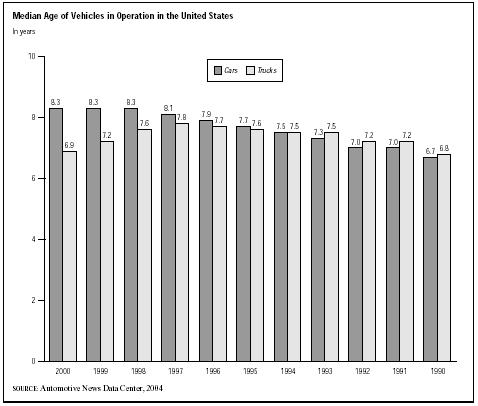SIC 5015
MOTOR VEHICLE PARTS, USED
This industry classification is comprised of establishments primarily engaged in the distribution of used motor vehicle parts at both the wholesale and retail level. It also includes establishments primarily engaged in dismantling motor vehicles for the purpose of selling parts. Establishments engaged in dismantling motor vehicles for the purpose of selling scrap are classified in SIC 5093: Scrap and Waste Materials.
NAICS Code(s)
421140 (Motor Vehicle Part (Used) Wholesalers)
According to D&B Sales & Marketing Solutions, there were 7,570 establishments engaged in the distribution of used vehicle parts at both the wholesale and retail level in 2002. Combined, they generated about $3.7 billion in sales. The average establishment had sales of $500,000.
The Alliance of Automobile Manufacturers reported that 95 percent of "retired cars from active use" are recycled. There were approximately 12,000 auto dismantler operations located throughout the United States. According to The National Independent Automobile Dealers Association (NIADA), there were more than 225 million vehicles in operation in 2003. The Automotive News Data Center, reported the average age of cars on the road were just over eight years old, and trucks with almost seven years in 2000.
States with the highest number of establishments in the used motor vehicle parts industry were Texas with 725, California with 639, and Florida with 457. Used automobile parts and supplies numbered 4,744 establishments, with revenues of $2.5 billion. Together, they employed some 23,407 people. The second largest segment was used motor vehicle parts, with 1,868 establishments. Together, they shared sales of $600.2 million.
During the early years of the automotive industry, the need for replacement parts became apparent. Although manufacturers typically provided parts for their vehicles through franchised distributors, many car makers did not survive the early decades of the twentieth century, thus leaving "orphan" vehicles behind. These vehicles had a need for replacement parts that no manufacturer was producing.
Replacement parts became available through two channels. Some companies purchased tracings, drawings, and blueprints for parts from bankrupt manufacturers in order to fabricate replacement parts. Others obtained parts from broken-down vehicles and reconditioned them for resale. As the automotive industry matured and cars became a ubiquitous part of the American landscape, the need for replacement parts continued to grow.
The National Automotive Parts Association (NAPA) was founded in 1925 to meet America's growing need for an auto parts distribution system. This distribution system accommodated 200,000 part numbers in 1999. NAPA members supplied new and reconditioned products to repair shops, service stations, fleet operators, automobile dealers, and individual consumers.
The Automotive Recyclers Association (ARA) reported 1997 gross annual revenues of $7.05 billion in the U.S. That same year 4.7 million vehicles were acquired for the purpose of recycling. There were more than 6,000 automotive recycling businesses in the United States employing more than 46,000 people. An estimated 86 percent of these establishments were full-service and employed ten or fewer people.
In 1998, a reported 205 million vehicles were in use in the United States with an average age of eight years. As the total number of motor vehicles increased, so did the market for used auto parts. A major channel for

obtaining these was through recyclers of scrapped or wrecked vehicles. Used parts often cost substantially less than new parts and could be located quickly through communications systems that linked auto recycling businesses, according to Brad Rose of the Automotive Recyclers of Michigan.
The leader in this market in 1998 was Genuine Parts Company (GPC), which operated the NAPA outlets. Genuine Parts Company was founded in 1928. It was a service organization that engaged in the distribution of automotive replacement parts. In 1998, its NAPA Auto Parts Group increased sales by six percent. In 1998, total sales for Genuine Parts Company were $6.6 billion, an increase of ten percent over 1997 levels. In 2002, total sales were $8,258.9 million. For 2003, sales increased to $8,449.3 million, an increase of three percent. Blonders of Hartford, Lubacks and Co., Recycled Auto Parts of Brattleboro Inc., and Road Tested Recycled Auto Parts Inc. were also well known in the industry.
Ford Motor Company entered the recycling business in 1999, when it purchased "Kwik-Fit," Europe's largest independent "Fast-fit" repair chain, and a facility in Tampa, Florida, to disassemble cars and trucks. Customers included insurers and body shops and retail customers. Ford opened a Web site where customers could order parts online and the recycling unit would deliver it by express mail directly from its factories.
Further Reading
Alliance of Automobile Manufacturers, 2004. Available from http://www.autoalliance.org/environment/recycling.php .
D&B Sales & Marketing Solutions, May 2004. Available from http://www.zapdata.com .
Hoover's Company Profiles, May 2004. Available from http://www.hoovers.com .
"U.S. Vehicle Population." Automotive News Data Center, 2004. Available from http://www.autonews.com/files/00regvehiclepop.pdf .
Comment about this article, ask questions, or add new information about this topic: